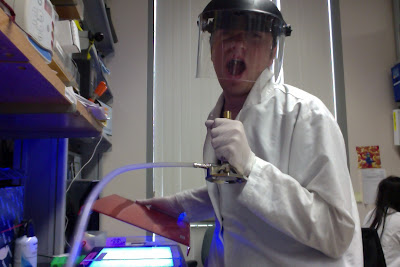Hey guys!
So it’s been a while since I last checked in (sorry, I know
you’re simply dying to hear about my
latest experiences) and so many fun things have gone on in the past few weeks
that it’ll be hard to keep things brief. I’ll do my best!
4th of
July: simply amazing. Photos below! We watched the best fireworks show I’ve
ever seen in my life (timed perfectly to music) from behind MIT; the police
presence was massive due to events earlier this year, and the show got pretty
emotional. Boston Strong.
Research: things
are going great! I’ve finished my first experiment, which was… completely
inconclusive. But at least I know how to do in
situs now, and I’ve been pretty self-directed the past two weeks while my
mentor is in Spain- I know, I’m jealous of her too. I’m hoping to get more
results from a second experiment next week, the fish have been reluctant to
give me embryos (how selfish of them, right?) but I finally got things started
this week. And I have to have a poster done in another two weeks. Where has
this summer gone??

NYC: I travelled
to the concrete jungle where dreams are made of last weekend. Wow. It was really hot and quite a change from the
quiet, tree-lined streets of Cambridge. I ate some of the best food I’ve had
all summer and ran around to all the places tourists flock to: Wall Street, the
new World Trade Center, Staten Island, the Statue of Liberty, Central Park,
Times Square, the Highline. And we did everything in one day! Needless to say
my friend I was staying with was not amused with me dragging him around the
city all day, but a few scoops of gelato made up for things. I also got to peek
at a few of the schools I will be applying to in the fall for PhD programs,
which has just made me more excited to continue my education.

Flour: I
discovered this bakery down the street from where I’m living and any ideas of
getting in shape/eating healthy this summer have officially been demolished.
Just look at the picture of the sticky bun below and you’ll understand. I also
woke up an hour early the other day to make sure I could get there for
breakfast and still get to lab on time. Dedication.

Research seminars:
Woah, people who work in this area are phenomenal scientists. We have weekly
seminars where we get to meet the PI’s that everyone in my program is working
with, and talk a little about their background. I’m completely awed by how
everyone we have spoken with so far is so humble about their experiences, even
though many of them have founded the
institutions that they work in. Their dedication to translational research and
finding solutions to the diseases that are so devastating to humans is really
inspirational. It’s really made me consider why being involved in scientific
research is important to me, and has made me more focused on my goals in the
future.
There’s probably so much more that I could tell you about,
but I won’t drag you through an unnecessarily long blog post. Until next time!


















